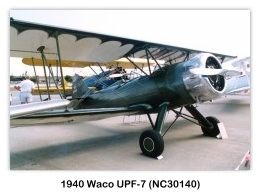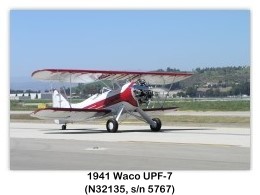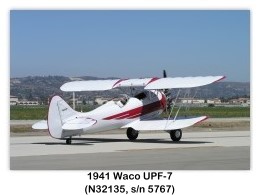

























Waco “UPF-7”
Single-engine two-seat biplane
Archive Photos
1940 Waco “UPF-7” “Lil Passion” (NC29338, s/n 5365), c.2009 on display at the Cable Air Show, Cable Airport, Upland, California (photos © 2009 Skytamer Images by John Shupek)





1940 Waco “UPF-7” (NC30140, s/n 5537), c.1998 on display at the Hawthorne Air Faire, Hawthorne, California (photo © 1998 Skytamer Images by John Shupek)

1940 Waco “UPF-7” (NC30140, s/n 5537), c.2000 on display at the 2000 Torrance Airshow, Zamperini Field, Torrance, California (photo © 2000 Skytamer Images by John Shupek)

1941 Waco “UPF-7” (N32135, s/n 5767), c.2005 on display at the 2005 Camarillo Air Show, Camarillo, California (photos © 2005 Skytamer Images by John Shupek)


Overview 2
- Role: Open-cockpit biplane
- National origin: United States
- Manufacturer: Waco Aircraft Company
- Introduced: 1930
- Status: YMF-5 in production
- Primary user: Private pilot owners and training schools
The Waco F series was a range of American-built private pilot owner and training biplanes of the 1930s from the Waco Aircraft Company.
Development 2
The Waco "F" series of biplanes supplanted and then replaced the earlier Waco "O" series of 1927 to 1933. The Waco "F" series had an airframe which was smaller and about 450 lbs lighter than the Waco "O" series, while continuing to provide accommodation for three persons in tandem open cockpits. A similar performance to the earlier model was obtained on the power of smaller and more economical engines.
The initial models were the Waco INF with a 125-hp (93 kW) Kinner engine, the Waco KNF with a 100-hp (75 kW) Kinner engine, and the Waco RNF with a 110-hp (82 kW) Warner Scarab engine, all of which had externally braced tailwheel undercarriages. Many further sub-models followed with more powerful engines of up to 225-hp (168 kW).
Operational History 2
The Waco "F" series was popular with private owner pilots for sporting and other uses and continued in production through the late 1930s. The tandem cockpit Waco UPF-7 version was adopted by the Civilian Pilot Training Program and continued to be built in numbers (over 600) until 1942. The Waco YMF of 1934, which had a modified wider and longer fuselage, was returned to production in March 1986 by WACO Classic Aircraft of Lansing Michigan as the Waco YMF-5. Over 100 Waco YMF-5s have been completed by WACO Classic Aircraft and the type remains in low-rate production. Considerable numbers of Waco "F" series biplanes, both original and newly built, remained in service in mid-2009.
Variants (in approximate chronological order) 2
- Waco INF: 125-hp (93 kW) Kinner B-5
- Waco KNF: 100-hp (75 kW) Kinner K-5
- Waco RNF: 110-hp (82 kW) Warner Scarab
- Waco PCF: 170-hp (127 kW) Jacobs LA-1 and new cross-braced undercarriage
- Waco PBF: as Waco PCF with modified "B" wings
- Waco QCF: 165-hp (123 kW) Continental A70
- Waco UBF: 210-hp (157 kW) Continental R-670
- Waco UMF: 210-hp (157 kW) Continental R-670A and longer wider fuselage and larger vertical fin
- Waco YMF: as Waco UMF with 225-hp (168 kW) Jacobs L-4
- Waco YPF-6 and YPF-7: 225-hp (168 kW) Jacobs L-4
- Waco UPF-7: tandem training version with wider-track undercarriage and 220-hp (164 kW) Continental radial (designated PT-14 by the USAAC)
- Waco YMF-5: built by WACO Classic Aircraft from March 1986 onwards. In June 2009 the company unveiled the latest updated variant, the YMF-5D
Note: from 1936 Waco added year suffixes to designations - e.g. YPF-6, YPF-7, with the numeral being the last figure of the year of manufacture
Specifications and Performance Data 3
Type:
- Two-seat primary training biplane.
Wings:
- Unequal-span single-bay wire-braced biplane.
- Center section carried above fuselage by splayed-out "N"-struts.
- One set of "N"-type interplane struts on each side of fuselage.
- Structure consists of two spruce spars, girder-type spruce ribs with plywood gussets, metal leading-edge Back to front spar, the whole covered with fabric.
- Metal-covered ailerons on all four wings.
Fuselage:
- Welded steel-tube framework covered with fabric-over light wood fairing structure.
Tail Unit:
- Braced monoplane type.
- Fixed surfaces have spruce spars and aluminium-alloy flanged web-type ribs, the whole being fabric-covered.
- Rudder and elevators have welded steel-tube framework covered with fabric.
Undercarriage:
- Divided type.
- Consists of two Waco oleo-spring shock-absorber struts braced by Backwardly-inclined and transverse streamline steel tubes.
- Medium-pressure wheels and hydraulic brakes.
- Fully-castoring tail-wheel.
Power Plant:
- Model UPF: One 220-hp Continental R-670-3
- Model YPF: One 225-hp Jacobs R755-5
- Model LPF: One 220-hp Lycoming R-680-7
- Radial air-cooled engine on welded steel-tube mounting.
- NACA cowling.
- Curtiss-Reed fixed-pitch metal airscrew.
- Fuel capacity: 60 U.S. gallons (189 liters)
- Oil capacity: 4 U.S. gallons (15.2 liters)
Accommodation:
- Tandem open cockpits with complete dual controls.
Dimensions:
- Span: 30 ft (9.14 m)
- Length: 23 ft 1 in (7.06 m)
- Height: 8 ft 5 in (2.56 m)
- Wing area: 244 ft2 (22.67 m2)
Weights:
- Weight empty: 1,870 lbs (848 kg)
- Disposable load: 746 lbs (399 kg)
- Weight loaded: 2,650 lbs (1,201 kg)
Performance (Model UPF)
- Maximum speed at sea level: 138.6 mph (223 km/h)
- Cruising speed at 75% power: 123 mph (198 km/h)
- Climb to 9,000 ft (2,745 m): 15 minutes
- Service ceiling: 15,800 ft (4,816 m)
Performance (Model YPF)
- Maximum speed at sea level: 141 mph (226.8 km/h)
- Cruising speed at 75% power: 117 mph (188 km/h.)
- Climb to 9,000 ft (2,745 m): 14 minutes
- Service ceiling: 16,500 ft (5,030 m)
Performance (Model LPF)
- Maximum speed at sea level: 136 mph (219 km/h)
- Cruising speed at 75% power: 120 mph (193 km/h)
- Climb to 9,000 ft (2,745 m): 14.5 minutes
- Service ceiling: 16,000 ft (4,878 m)
Credits and Works Cited
- Photos, John Shupek, Copyright © 1998-2009 Skytamer Images. ALL RIGHTS RESERVED
- Wikepedia. "Taylorcraft B." [Online] Available https://en.wikipedia.org/wiki/Taylorcraft_B, 04 October 2009
- Bridgman, Leonard (ed.) Jane's All The WorlD’s Aircraft 1941. New York, The MacMillan Company, 1942, pp 231c.
Copyright © 1998-Present, Skytamer Images, Whittier, California
All rights reserved































































